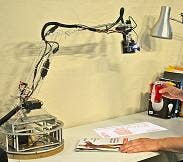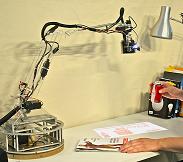MIT’s Robot Lamp with Augmented Reality (video)

Share
MIT has created its own version of a magic lamp. Nathan Linder of the Fluid Interfaces Group at MIT Media Lab has created the LuminAR Bulb, a compact system that combines a pico projector, wireless computer, and camera all in a package that can screw into a regular light socket. The LuminAR Bulb can obey gesture controls and project images onto surfaces, creating an augmented reality interface. To match the potential of the bulb, Linder also created the LuminAR Lamp, a robotic arm that can move and pivot the LuminAR Bulb in any direction. Watch the amazing system in action in the video below.
Projects like LuminAR show that a computer can look like almost anything, and can be placed almost anywhere. This versatility may allow us to rethink the way we interact with computers. We've already seen how the next generation of computers may come in radically new sizes and shapes, such as a child's building blocks. A whole new range of items may become 'computerized' - embedded with compact and powerful processing tools. Ultimately, this may lead us to creating an Internet of Things, a system where every physical object has the computing power to interact with (and exist within) the digital realm. For now, Linder and the Fluid Interfaces Group seem intent on breaking the computer out of the 'prison' created by the rigid form of monitors, desktops, and keyboards.
LuminAR sort of appears like a stationary version of Pranav Mistry's Sixth Sense personal augmented reality device. It's no surprise. Both Linder and Mistry have Pattie Maes (head of the Fluid Interfaces Group) as their advisor. Just as with Sixth Sense, LuminAR opens up a realm of new interactions, letting any object become the location for both commanding a computer, and viewing its output. There's no need for a screen - you have a projector. There's no need for a keyboard - the camera can read your movements as input. It's a computer set free.
Be Part of the Future
Sign up to receive top stories about groundbreaking technologies and visionary thinkers from SingularityHub.


The practical applications of an augmented reality lamp are rather thrilling. Using the camera, pico projector, and wireless connection, the LuminAR Bulb could let different people work in different physical spaces while sharing the same virtual space. Coworkers on opposite ends of the planet could have a shared work environment right on their own desk - one that responds to gestures. I could 'pick up' a virtual object, move it around, and you could watch and then do the same with your LuminAR. Augmented reality could also enhance magazines, books, and other physical objects with projected displays and data. The robot arm would allow the system to move and adapt to your needs - projecting in an open area, or overlapping its image with the corresponding real world object.
Any project where a robot arm is just a periphery to the real action is something to get excited about. The LuminAR Bulb has the capability to bring augmented reality, responsive computer interactions, and collaborative spaces to any home or office. And it fits in a regular light socket! C'mon that's pretty incredible. Of course, it only hints at the potential we can achieve when we break computers out of their standard forms. LuminAR is just one cool example of 'waking up' our everyday objects, of turning everything into programmable material. Today, MIT is letting you use hand signals to tell your lamp which videos to play. Next, our chairs could follow us to another room at the snap of our fingers. Or your clothes may track your health and alert a hospital if you have a heart attack. Given enough time computers may take the shape of everything around you. Which is cool, because I've been yelling commands at my furniture for years now and it would be nice if it actually started following my orders.
[image and video credits: MIT Media Lab]
[source: Fluid Interfaces Group]
Related Articles

How Scientists Are Growing Computers From Human Brain Cells—and Why They Want to Keep Doing It

These Brain Implants Are Smaller Than Cells and Can Be Injected Into Veins

This Wireless Brain Implant Is Smaller Than a Grain of Salt
What we’re reading
